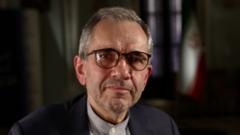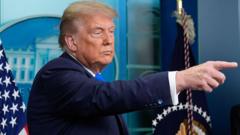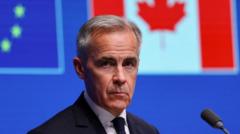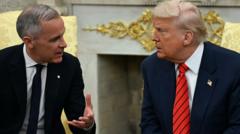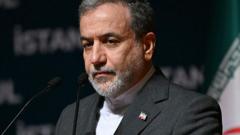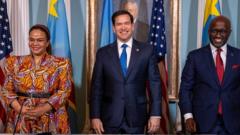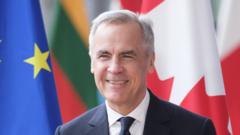As Prime Minister Mark Carney engages with President Trump over the Golden Dome missile defense system, experts raise concerns about its feasibility and funding.
Canada Considers Joining Trump's Ambitious Golden Dome Defense Initiative
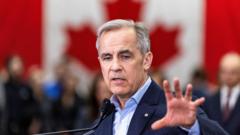
Canada Considers Joining Trump's Ambitious Golden Dome Defense Initiative
Canada seeks collaboration with the U.S. on the newly proposed missile defense initiative as security discussions evolve.
The Canadian government is currently in discussions with the United States regarding its potential involvement in President Trump's proposed "Golden Dome" missile defense initiative, designed to counter emerging aerial threats. In a statement from Prime Minister Mark Carney's office, it was confirmed that conversations are ongoing, encompassing both current and prospective security programs, including the Golden Dome.
President Trump introduced the missile defense plan on Tuesday, estimating its initial cost at $25 billion (£18.7 billion) and noted that Canada has shown interest in participating. While details on financial contributions and operational aspects remain vague, the discussions are part of broader negotiations regarding trade and security between Canada and the United States, particularly following a series of threats from Trump concerning tariffs and the suggestion that Canada would benefit from becoming a U.S. state.
Audrey Champoux, a spokesperson for Carney, emphasized the strong mandate given to the Prime Minister by Canadians to forge a new, comprehensive economic and security relationship with the U.S. "These discussions naturally include strengthening Norad [North American Aerospace Defense Command] and related initiatives such as the Golden Dome," she expressed, although the timeline for Canada's possible financial involvement remains undetermined.
President Trump highlighted Canada's interest, stating that they seek protection and he is prepared to assist. Though he projected that the Golden Dome defense system would be functional by the end of his presidency, the estimated total expenditure for the initiative could escalate to $175 billion. Further complicating matters, the Congressional Budget Office has projected that just the space components might amount to around $542 billion over two decades. The U.S. and Canada already collaborate through Norad, which has provided aerospace and maritime defense since 1958 and is currently under modernization discussions.
The Golden Dome initiative aims to address emerging threats from advanced aerial weaponry, including hypersonic missiles, and is expected to feature space-based sensors and interceptor capabilities. Trump likened the system to Israel's Iron Dome, credited with intercepting numerous hostile projectiles since its inception in 2011. However, defense analysts like Shashank Joshi express skepticism about the feasibility of creating such an extensive and effective defense network across the vast U.S. landmass. He outlined a potential operational framework where thousands of satellites would detect and monitor missile launches, enabling interceptors in orbit to engage during a missile's ascent.
Despite the high stakes of the Golden Dome initiative, many remain uncertain about its execution within the projected timeline and the substantial financial implications it would impose on the U.S. defense budget.
President Trump introduced the missile defense plan on Tuesday, estimating its initial cost at $25 billion (£18.7 billion) and noted that Canada has shown interest in participating. While details on financial contributions and operational aspects remain vague, the discussions are part of broader negotiations regarding trade and security between Canada and the United States, particularly following a series of threats from Trump concerning tariffs and the suggestion that Canada would benefit from becoming a U.S. state.
Audrey Champoux, a spokesperson for Carney, emphasized the strong mandate given to the Prime Minister by Canadians to forge a new, comprehensive economic and security relationship with the U.S. "These discussions naturally include strengthening Norad [North American Aerospace Defense Command] and related initiatives such as the Golden Dome," she expressed, although the timeline for Canada's possible financial involvement remains undetermined.
President Trump highlighted Canada's interest, stating that they seek protection and he is prepared to assist. Though he projected that the Golden Dome defense system would be functional by the end of his presidency, the estimated total expenditure for the initiative could escalate to $175 billion. Further complicating matters, the Congressional Budget Office has projected that just the space components might amount to around $542 billion over two decades. The U.S. and Canada already collaborate through Norad, which has provided aerospace and maritime defense since 1958 and is currently under modernization discussions.
The Golden Dome initiative aims to address emerging threats from advanced aerial weaponry, including hypersonic missiles, and is expected to feature space-based sensors and interceptor capabilities. Trump likened the system to Israel's Iron Dome, credited with intercepting numerous hostile projectiles since its inception in 2011. However, defense analysts like Shashank Joshi express skepticism about the feasibility of creating such an extensive and effective defense network across the vast U.S. landmass. He outlined a potential operational framework where thousands of satellites would detect and monitor missile launches, enabling interceptors in orbit to engage during a missile's ascent.
Despite the high stakes of the Golden Dome initiative, many remain uncertain about its execution within the projected timeline and the substantial financial implications it would impose on the U.S. defense budget.








